Related Research Articles
The Wiradjuri people are a group of Aboriginal Australian people from central New South Wales, united by common descent through kinship and shared traditions. They survived as skilled hunter-fisher-gatherers, in family groups or clans, and many still use knowledge of hunting and gathering techniques as part of their customary life.

The Wurundjeripeople are an Australian Aboriginal people of the Woiwurrung language group, in the Kulin nation. They are the traditional owners of the Yarra River Valley, covering much of the present location of Melbourne. They continue to live in this area and throughout Australia. They were called the Yarra tribe by early European colonists.

John Batman was an Australian grazier, entrepreneur and explorer. He is best known for his role in the founding of Melbourne.

The Eora are an Aboriginal Australian people of New South Wales. Eora is the name given by the earliest European settlers to a group of Aboriginal people belonging to the clans along the coastal area of what is now known as the Sydney basin, in New South Wales, Australia. The Eora share a language with the Darug people, whose traditional lands lie further inland, to the west of the Eora.

Pemulwuy, was a Bidjigal warrior of the Dharug nation, born around 1750 in the area of Botany Bay in New South Wales, Australia. One of the most famous Aboriginal resistance fighters in the colonial era, he is noted for his resistance to European colonisation which began with the arrival of the First Fleet in January 1788.

William Barak, named Beruk by his parents, the "last chief of the Yarra Yarra tribe", was the last traditional ngurungaeta (elder) of the Wurundjeri-willam clan, the pre-colonial inhabitants of present-day Melbourne, Australia. He became an influential spokesman for Aboriginal social justice and an important informant on Wurundjeri cultural lore.
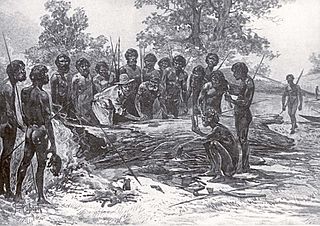
Batman's Treaty was an agreement between John Batman, an Australian grazier, businessman and coloniser, and a group of Wurundjeri elders, for the purchase of land around Port Phillip, near the present site of Melbourne. The document came to be known as Batman's Treaty and is considered significant as it was the first and only documented time when Europeans negotiated their presence and occupation of Aboriginal lands directly with the traditional owners. The treaty was implicitly declared void on 26 August 1835 by the Governor of New South Wales, Richard Bourke.
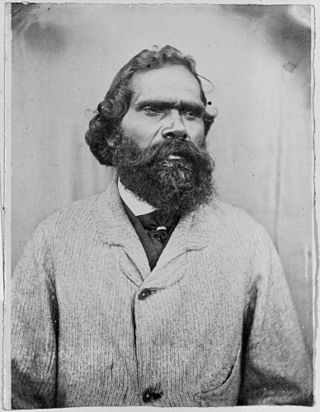
Simon Wonga, ngurungaeta and son of Billibellary, was an elder of the Wurundjeri people, who lived in the Melbourne area of Australia before European settlement. He was resolute that his people would survive the "onslaught" of white men.

The Dharug language, also spelt Darug, Dharuk, and other variants, and also known as the Sydney language, Gadigal language, is an Australian Aboriginal language of the Yuin–Kuric group that was traditionally spoken in the region of Sydney, New South Wales, until it became extinct due to effects of colonisation. It is the traditional language of the Dharug people. The Dharug population has greatly diminished since the onset of colonisation. Eora language has sometimes been used to distinguish a coastal dialect from hinterland dialects, but there is no evidence that Aboriginal peoples ever used this term, which simply means "people". Some effort has been put into reviving a reconstructed form of the language.
The murnong or yam daisy is any of the plants Microseris walteri, Microseris lanceolata and Microseris scapigera, which are an important food source for many Aboriginal peoples in southern parts of Australia. Murnong is a Woiwurrung word for the plant, used by the Wurundjeri people and possibly other clans of the Kulin nation. They are called by a variety of names in the many different Aboriginal Australian languages, and occur in many oral traditions as part of Dreamtime stories.
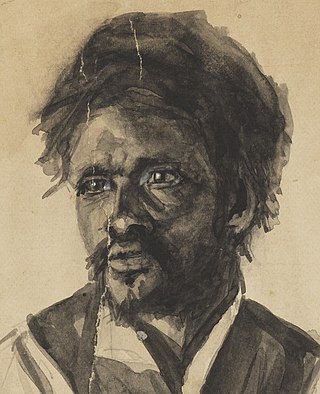
Musquito was an Indigenous Australian resistance leader, convict hunter and outlaw based firstly in the Sydney region of the British colony of New South Wales and later in Van Diemen's Land.
Barangaroo was a member of the Cammeraygal clan of Aboriginal Australians during the early period of the British colonisation of Australia. She is most well known as being the second wife of Bennelong, who was a pioneering interlocutor between the Aboriginal people and the early British military establishment in New South Wales.

The Bidjigal people are an Aboriginal Australian people whose traditional lands are modern-day western, north-western, south-eastern, and southern Sydney, in New South Wales, Australia. The land includes the Bidjigal Reserve, Salt Pan Creek and the Georges River. They are part of the Dharug language group, and there is debate as to whether the clan is part of the Dharug or Eora people.

The Australian frontier wars were the violent conflicts between Indigenous Australians and primarily British settlers during the colonial period of Australia.

The Woiwurrung, also spelt Woi-wurrung, Woi Wurrung, Woiwurrong, Woiworung, Wuywurung, are an Aboriginal Australian people of the Woiwurrung language group, in the Kulin alliance.
Patyegarang was an Australian Aboriginal woman, thought to be from the Cammeraygal clan of the Dharug nation. Patyegarang taught William Dawes the language of her people and is thought to be one of the first people to have taught an Aboriginal language to the early colonists in New South Wales.

Tunnerminnerwait (c.1812–1842) was an Australian Aboriginal resistance fighter and Parperloihener clansman from Tasmania. He was also known by several other names including Pevay, Jack of Cape Grim, Tunninerpareway and renamed Jack Napoleon Tarraparrura by George Robinson.
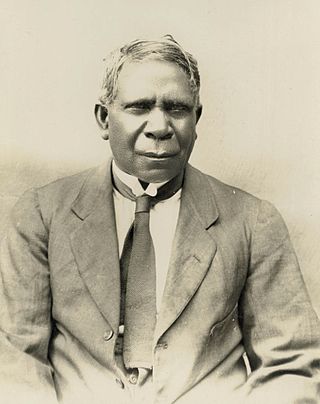
Indigenous Australian literature is the fiction, plays, poems, essays and other works authored by Aboriginal and Torres Strait Islander people of Australia.

Turandurey was a Wiradjuri woman from the Lachlan River area in central New South Wales near where the town of Hillston is now located. Turandurey is noted for her work as a guide and interpreter to the explorer Thomas Mitchell, while at the same time caring for her daughter Ballandella.
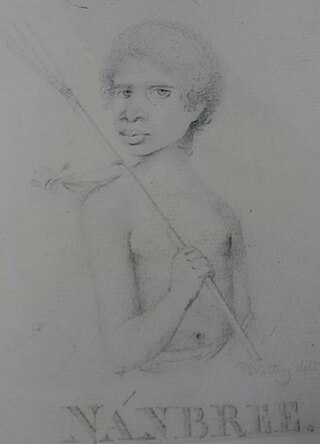
Nanbaree, also named Nanbarry and Andrew Snape Hamond Douglass White, was an Aboriginal Australian of the Gadigal clan who undertook a prominent role in establishing communication between the Aboriginal people and the colonists during the early stages of British occupation of the Sydney area. While still a child, he was the first Aboriginal Australian to acquire a functional level of English and became an important interpreter as he had very close kinship ties with prominent figures such as Bennelong and Colebe. During adulthood, he became a notable sailor, voyaging with Matthew Flinders.
References
- ↑ "BRAVE ABORIGINAL GIRL". Eastern Districts Chronicle. Vol. XXXVII, no. 9. Western Australia. 27 February 1914. p. 7. Retrieved 8 November 2017– via National Library of Australia.
- ↑ "AN ABORIGINAL S BRAVERY". The Evening Star . Vol. 13, no. 3996. Western Australia. 8 March 1911. p. 3. Retrieved 8 November 2017– via National Library of Australia.
- ↑ "THE ROPER RIVER". The Evening Star . Vol. 15, no. 4356. Western Australia. 8 May 1912. p. 3. Retrieved 8 November 2017– via National Library of Australia.